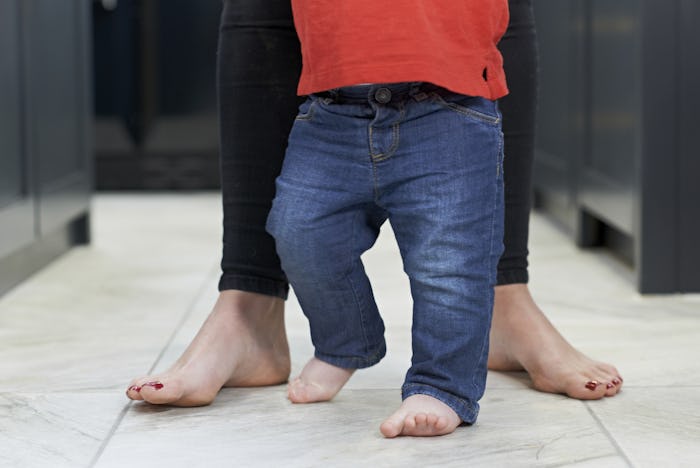Life

If You're Constantly Buying Shoes For Your Kids, Here's Why
Sometimes I feel like no matter which shoes I pick out for my 2-year-old daughter, I am either going to be squeezing her toes into sneakers that are a bit too small, or watching her flop around in sandals that are half a size too big. It’s tough to find kids’ shoes that fit well, especially when they go from a chubby baby to a lanky toddler seemingly overnight. But how fast do your kids feet grow?
"It's really hard to predict the growth of children's feet, and impractical to do so," says Dr. Barbara Bergin, a board-certified orthopedic surgeon in Austin, Texas, in an email interview with Romper. "Suffice it to say that children's feet are going to grow, some of them quite large."
As for guidelines, Bergin says girls pretty much stop growing once they start menstruation, whereas boys continue to grow into their early 20s. "But as a parent, I remember really having to keep up with foot growth while they were in middle school," she adds.
According to Bergin, while children's foot growth doesn't seem to have much clinical importance, it is important for children to wear shoes that fit. She explains that wearing tight shoes can have long term clinical implications, especially in girls, who tend to wear tight shoes and high heels. Combine too-tight footwear with some genetic predispositions, and Bergin says foot deformities, like bunions, hammertoes, and bunionettes, may result.
"This all starts early, and then as adults — when we're able to make our own bad decisions — we continue to fan the fire," she says.
There are general guidelines that can help parents know a range for what to expect in foot growth, says the Institute for Preventive Foot Health (IPFH). For example, toddlers between 15 months and 2 years will see about a half size increase every two to three months, while a child between 3 and 5 years will see about a half size increase every four months.
But, like Bergin, the IPFH is quick to discourage ill-fitting footwear, quoting a study that found 89 percent of children wore indoor footwear that was of insufficient length and 69 percent of children wore outdoor shoes that didn't fit properly.
Bergin says the good news is that footwear options are becoming expansive, and include stylish sneakers and supportive flats that can be worn throughout the day, including those designed for kids.
Now if moms could just get them to stop throwing them in the middle of the living room, then everyone would be set, am I right?